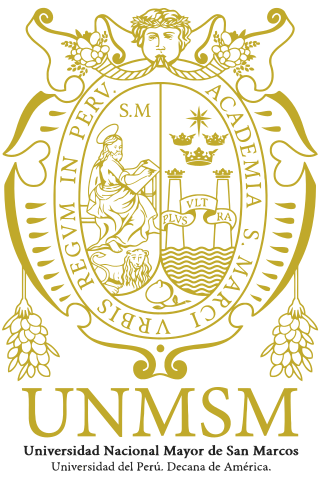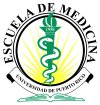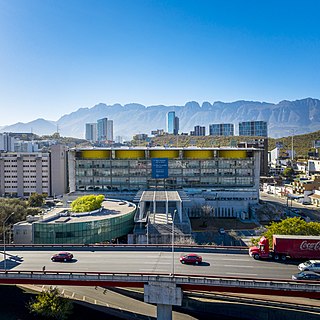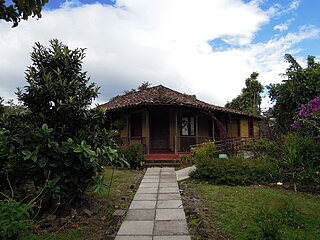
The University of Trás-os-Montes and Alto Douro is a public university located in the north-eastern city of Vila Real, Portugal.

La Plata is the capital city of Buenos Aires Province, Argentina. According to the 2022 census, it has a population of 772,618 and its metropolitan area, the Greater La Plata, has 938,287 inhabitants. It is located 9 kilometers inland from the southern shore of the Río de la Plata estuary.

The National University of San Marcos is a public research university located in Lima, the capital of Peru. It is considered the most important, recognized and representative educational institution at the national level. At the continental level, it is the first officially established and the oldest continuously operating university in the Americas, which is why it appears in official documents and publications as "University of Peru, Dean University of the Americas". It had its beginnings in the general studies that were offered in the cloisters of the convent of the Rosario of the order of Santo Domingo —current Basilica and Convent of Santo Domingo— around 1548. Its official foundation was conceived by Fray Thomas de San Martín on May 12, 1551; with the decree of Emperor Carlos I of Spain and V of the Holy Roman Empire, in 1571, it acquired the degree of pontifical granted by Pope Pius V with which it ended up being named as the "Royal and Pontifical University of the City of the Kings of Lima". Being recognized by the Spanish Crown as the first university in America officially founded by Real cédula, it is also referred to as the "University of Lima" throughout the Viceroyalty. Throughout its history, the university had a total of four colleges under tutelage: the Colegio Real y Mayor de San Martín and the Colegio Real y Mayor de San Felipe y San Marcos, the Real Colegio de San Carlos —focused on law and letters, derived from the merger of the two previous ones—and the Royal College of San Fernando—focused on medicine and surgery—. In the times of emancipation, it acquired a main role in the formation of several of the leaders managing the independence of Peru. After the proclamation of independence and during the republic, it maintains both colloquially and formally —in various treaties and documents historical—its name as "University of Lima" until 1946, the year in which its current name and denomination as National and Major University were made official.
Education in Mexico has a long history. Indigenous peoples created institutions such as the telpochcalli and the calmecac. The Royal and Pontifical University of Mexico, the second oldest university in the Americas, was founded by royal decree in 1551. Education in Mexico was, until the early twentieth century, largely confined to males from urban and wealthy segments and under the auspices of the Catholic Church.

The University of Puerto Rico, Medical Sciences Campus, School of Medicine is located in the University of Puerto Rico, Medical Sciences Campus in San Juan, Puerto Rico. It's the only medical school in the University of Puerto Rico System. It is accredited by the Liaison Committee on Medical Education (LCME). Its students are predominantly Puerto Rican residents. However, anyone is allowed to apply to this university. It is also considered the top bilingual medical school in the world due to its requirement for each admitted student to fully master both English and Spanish.

The National University of Costa Rica is one of five public universities in the Republic of Costa Rica, in Central America. The main campus is located in the city of Heredia. According to recent international studies, The National University of Costa Rica ranks 85th in Latin America and 1576th in the world. More than 12,000 students study in its main campus. In addition to offering a broad undergraduate curriculum, it offers 16 Master of Arts degrees. It is known for its strong programs in ecology, sociology and education.

The Mexican Academy of Sciences(Academia Mexicana de Ciencias) is a non-profit organization comprising over 1800 distinguished Mexican scientists, attached to various institutions in the country, as well as a number of eminent foreign colleagues, including various Nobel Prize winners. The organization, which encompasses exact and natural sciences as well as the social sciences and humanities, is founded on the belief that education, based on the truth of scientific knowledge, is the only means, in the short and long term, of achieving the development of the Mexican spirit and national sovereignty.

The Ignacio A. Santos School of Medicine is the medical school division of the Monterrey Institute of Technology and Higher Education (ITESM). Established in 1978 in Monterrey, Mexico.

Hugo Gunckel Lüer was a Chilean pharmacist, botanist, and university professor.

The Autonomous University of Chihuahua is a Mexican public university based in the city of Chihuahua, Chihuahua, but with several campuses across the state. In December 8, 1954, the State Legislature, with Governor Oscar Soto Maynez, issued the decree 171, which founded the Autonomous University of Chihuahua (UACh). UACh was granted its autonomy in 1968, with the freedom to define its own curriculum and manage its own budget without interference from the government.

The National University of the Northeast is an Argentine national university. It is located in the cities of Corrientes and Resistencia, capital cities of the Provinces of Corrientes and Chaco respectively, and was established on December 4, 1956. Known as the University of the Sun, it was the seventh-largest university in Argentina by student enrollment numbers as of 2017.

The Facultad de Ciencias Políticas y Sociales is a faculty within Mexico's Universidad Nacional Autónoma de México (UNAM), responsible for directing research and teaching programs in the fields of political science and social science. It was first established in 1951 as the Escuela Nacional de Ciencias Políticas y Sociales, before its conversion to full faculty status from 26 January 1968. FCPyS offers five academic degrees at the Licenciatura (undergraduate) level, in public administration, Communication studies, political science, international relations, sociology and anthropology. At a postgraduate level FCPyS offers Maestrías in five areas of study, and a Doctorado (doctorate) in political and social science that is oriented to one of five specialities. FCPyS also operates and has responsibility for a number of specialised semi-autonomous research institutions, such as the Centro de Relaciones Internacionales (CRI).

Luigi Fenaroli was an Italian botanist and agronomist.

The Sierra La Culata National Park Also Sierra de la Culata National Park is a national park of Venezuela that is located in the northeastern branch of the Venezuelan Andes, in the states Mérida and Trujillo. It was decreed a national park on December 7, 1989. It has a high mountain climate, with temperatures ranging between −2 and 24 °C, and its surface area is 200,400 hectares (774 sq mi).
The National Prize for Humanities and Social Sciences was created in Chile in 1992 under Law 19169. It is granted "to the humanist, scientist, or academic, who has distinguished himself for his contribution in the field of Human Sciences". The history field has its own National Award.

Santa Lucía is the fifth district of the Barva canton, in the Heredia province of Costa Rica.

The Pontevedra campus is one of three campuses that host the University of Vigo. It is located in the Spanish city of Pontevedra and offers undergraduate, postgraduate and doctoral studies in Social sciences, health sciences, arts, engineering and Sports.















